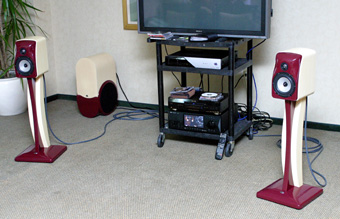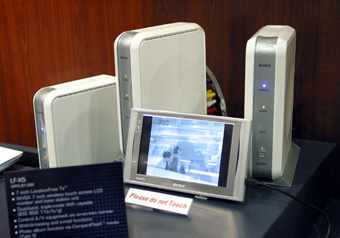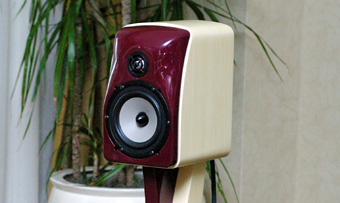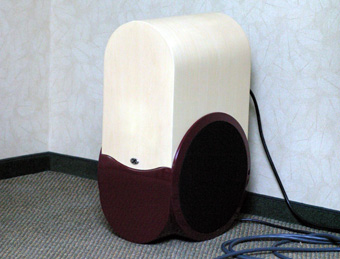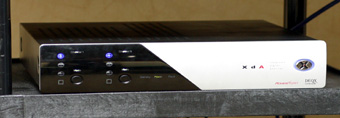![[SoundStage!]](../sslogo3.gif) The Traveler The TravelerBack Issue Article |
||
October 2004 The Coolest Audio Product at CEDIA Expo 2004: NHT’s DSP-Based Xd Loudspeaker System
Along with CES, CEDIA Expo has established itself as a hotbed for new A/V product releases. This year, though, there were not as many debuts of innovative products as there were refinements of older technologies and designs. Still, a few new products stood out. The coolest product was Sony’s LocationFree TV, which merges television and the Internet in a system that's truly portable -- and surprisingly affordable at $1099 USD. Nothing in the home-audio world was quite as attention-grabbing, but NHT’s new DSP-corrected loudspeaker system was close, and hot on the heels of Axiom's DSP-based subs that I discussed last month. Sense a trend? I do. NHT's new system may signal a revolution in loudspeaker technology as it appears to be, from the demonstration and explanation, very impressive. But before I go on, let me launch into a disclaimer. You might remember a few years ago when a manufacturer introduced a supposedly revolutionary new crossover technology that would, we were told, change the speaker world forever. Rumors flew, non-disclosure agreements were signed, and a privileged few sat and listened to a petite two-way monitor that many said sounded quite good. Others, including some audio journalists, were more ecstatic and bought into the whole idea that the speaker world was about to be turned upside down by this too-simple-to-be-true crossover technology. But there were dissenters. First, there were people who pointed out, quite rightly, that the demo wasn’t much of a demo at all, and any conclusions drawn from it weren’t all that valid. There was just one speaker model demonstrated and no reference against which to judge. Others were more critical, including one person whose ears and soldering iron I trust. As audiophile legend has it, he walked into the demo room, played something simple, and right on the spot not only proclaimed the crossover design inconsequential, but described what the technology was -- in detail -- and then declared that it was nothing new at all. Who was right and who was wrong? I don’t think we’ll ever know -- and I never really cared. All the secrecy and the lack of a credible demonstration put me off from the beginning. And I suspect the public, as well as the other speaker companies, didn’t care much either, because there were only a few speakers ever released to market with this "revolutionary" new crossover technology, and today I believe there is none. For me, the only important thing about this incident was the hoopla, and the journalists who bought into it without even trying to understand it. With that caveat covered, I’ll go into detail about what I saw and learned at NHT’s demo, which was held in the Marriott hotel across the street from the main convention area. NHT was trumpeting a new "DSP powered" loudspeaker system -- technology that will supposedly revolutionize the loudspeaker world again. As I walked across the street, memories of a few years prior became fresh in my mind. As I sat in the hotel lobby drinking a Starbucks latte, I wondered aloud to Marc Mickelson if I really wanted to go. Marc practically had to drag me there because, for a brief moment, I thought a second latte might be more to my liking. But I'm glad I did go. When one of NHT’s designers, Jay Doherty, started talking, my ears perked up and I didn’t need any more caffeine to get a charge. When he played the Xd speaker system, I heard a sound that was exceptionally clear and very big despite the system's small size.
Forget the term "DSP powered" -- it’s flashy-sounding, but it doesn’t really describe what NHT is doing all that well. DSP stands for digital signal processing, and it has been an important feature of Meridian's loudspeakers for 14 years. What NHT has created, digitally, is a crossover for the diminutive XdS satellite speakers and XdW subwoofer that corrects for frequency and phase response. It’s all done in a separate box called the XdA, which converts the incoming analog signal from your preamplifier to digital. The XdA also contains four amplifier modules that power the woofers and tweeters in the satellites. The XdW has its own built-in amp. It all adds up to a four-piece system that looks great and, based on the demo, sounds impressive as well. Admittedly, though, no non-DSP versions of the same products were played, so there was nothing against which to compare the sound we were hearing. On the other hand, I doubt there are any non-DSP versions of the speakers -- the XdS and XdW were designed from the ground up. The complete NHT Xd system sells for $5500, which is quite reasonable if you accept the notion that it may be groundbreaking. Yes, I said groundbreaking. As Doherty pointed out at the beginning of his demo, loudspeaker technology is inherently flawed because no single driver can produce the entire frequency band of human hearing properly. Designers therefore must split the frequency range up among different drive units that are optimized for certain frequencies, and then put the output from the drivers together again so it sums as one for our ears. It's a reality that the woofer handles part of the midrange and lows, while the tweeter handles the rest of the mids and highs (in a two-way system). In theory, it sounds nice, but in practice it never works ideally.The splitting is done in the crossover -- traditionally, a set of passive components (capacitors, inductors, yadda, yadda, yadda) that routes the signal to the drivers. The problem is that these passive components don’t pass the signal unadulterated. Things like "phase shift" (timing errors) contaminate the signal. Plus, the passive crossover can’t just shelve off frequencies like they’ve hit a wall. For example, let’s say that a crossover point is at 2000Hz (2kHz). Well, 2001Hz doesn’t go only to tweeter and 1999Hz to the woofer. With traditional crossovers the "overlap" between the drivers can be huge, and that overlap means that over certain parts of the frequency band both drivers are producing the same sound. That is not necessarily a good thing, but it's a fact of life in the speaker world -- at least as we've known it until now. Compounding this problem is the fact that the drivers don’t just put everything together nicely in mid-air. For example, a tweeter is in one spot on the cabinet and the woofer is in another. Also, remember that over part of the frequency band they’re producing the same frequencies. The goal is to get those frequencies to "sum" correctly in mid-air -- both on- and off-axis, horizontally and vertically. Is that an easy thing? Notta chance. Let’s say that through some careful trickery in your crossover and some skilled placement on the cabinet you get the two drivers to sum perfectly directly to the front. Does that mean that you’re going to be able to get them to sum the same to the side, or above, or below? Likely not -- not without a whole lot of work, and even then you’re going to run into problems. As Doherty pointed out, any passive speaker system, regardless of cost, will have those problems, mostly because you really have no control over time with passive components. As a result, timing (phase) errors become very real, audible anomalies. Enter DSP, the new world NHT now resides in, where bits and bytes can be manipulated in ways not possible in the passive-electronics world. Correction for frequency and phase now becomes possible. To create a digital crossover, NHT collaborated with an Australian company, DEQX (Digital Equalization and Crossover). DEQX was in charge of DSP design, and together the two companies created a loudspeaker system that rolls off the response of one driver to another at a rate of 300dB per octave. Compared to the 6-, 12-, 18-, or 24dB-per-octave roll-offs that we read about in typical passive designs, NHT's slopes are far steeper, which greatly reduces the overlap between the drivers. Furthermore, because the signal has been digitized, the NHT folks can correct for phase. The result, by working with this technology, is a speaker with tremendously even dispersion in the horizontal and vertical planes. Doherty showed us graphs to demonstrate the "suckout" that occurs with a standard crossover and shallow slopes versus the 300dB-per-octave DSP crossover NHT is using in the Xd system. Overall sound-power response of the speaker is thus well behaved, so you get a speaker that sounds quite similar on- and off-axis. Studies have shown that our ears like speakers that behave like this. Because NHT and DEQX were working in the digital domain, they were also able to correct the "linear time" and "frequency domain" errors that the individual drivers have. As mentioned, all this DSPing is done in the XdA -- but that’s not all. The XdA also houses four amplifier modules made by a California-based company called PowerPhysics. These are digital switching amplifiers that run extremely efficiently and therefore produce little heat -- precisely the reason all that processing and amplifier power can be packed into such a little box. Still, as impressive as the Xd system was, I had questions. The first was, "Why 300dB-per-octave slopes and not greater?" Doherty looked down, then up, and declared, "Time! Otherwise we could use 10,000dB-per-octave slopes." In the digital world you have control over time, but in the audio and video worlds, there are still some timing considerations. In time (sorry), this technology will be married to a complete multichannel home-theater setup. In that kind of setup, the sound must sync to the video image -- this means that the DSP must have finished its processing so, for example, the dialogue through the speakers matches the actors’ mouth movements on the screen. After all, with all this new technology, we don’t want to usher into the world an entirely new generation of out-of-sync movies like those old martial-arts films. According to Doherty, the time constraint NHT is working with, so that synching between audio and video is "good," is eight-and-a-half milliseconds. My next question (I know demonstrators hate it when I’m in the room and they see my hand inching upward) revolved around the XdA and what it does, or, rather, doesn’t do. The XdA only accepts an analog input signal from, say, a preamplifier or source with volume control. The XdA digitizes that analog signal so it can work with it in the digital domain. Obviously, I wondered why the XdA didn’t accept an incoming digital signal so a conversion step could be eliminated, and then why there wasn’t a volume knob attached to negate the need for a preamplifier altogether. In short, Doherty told us that NHT considered the options and then made a "design decision" to do it the way they did it. While I was at the demonstration I wondered to myself if they made the correct decision because at that time a digital input jack and volume control seemed logical. In the week that followed, though, I came to the conclusion that NHT likely did make the correct decision, but it was only when I looked at the active loudspeakers that I have at home, the Paradigm Reference Active/40s. The Active/40s aren’t DSP corrected, but they do contain the requisite crossovers, amplifiers, and other components that make up a set of active loudspeakers. They don’t, mind you, have the volume control or switching capabilities of a preamplifier, and it would really be silly if they did. What's next, a CD tray on top? What NHT has created is the DSP equivalent of the traditional active loudspeaker, and it just so happens that NHT's crossover and amplifiers are in a separate box, and that's where the desire to make that box a digital preamplifier sets in. I can’t say definitively that NHT’s new loudspeaker technology will make everything else in the world obsolete, but I do see DSP technology in loudspeakers as a growing trend. I bet that at CEDIA 2005, Sony won't be the only company with portable, Internet-capable TVs, and NHT won't be the only company showing a DSP loudspeaker system. ...Doug Schneider To learn more about NHT, visit www.nhthifi.com. For information on DEQX, visit www.deqx.com.
|
||
|
||
![[SoundStage!]](../sslogo3.gif) All Contents All ContentsCopyright © 2004 SoundStage! All Rights Reserved |
